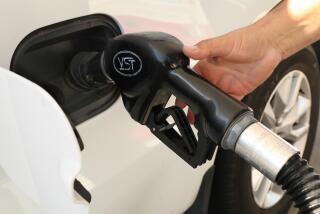Gasoline Hits 5-Month High : Prices: But despite some public suspicion, there’s no sign of price gouging. Experts attribute it to a seasonal rise in demand.
- Share via
Gasoline prices at the pump have soared in recent weeks, and the biggest price hikes have come in Southern California.
But contrary to the view of a distrustful, recession- and riot-weary public, oil industry experts and others see higher prices more as a sign that the economy is recovering than evidence of price gouging by dealers or suppliers.
In Los Angeles, “demand has been surging,” according to Trilby Lundberg, publisher of the Lundberg Letter, which surveys gasoline and oil markets.
Nationally, the American Automobile Assn. reported Tuesday that the average price of self-serve regular unleaded gasoline increased 1.4 cents this week, to $1.121 a gallon--the highest average price since December.
But much of this price rise comes from a predictable seasonal shift to summer--a pattern that was most recently interrupted two years ago by the Persian Gulf crisis.
“People are looking to travel more, and they are driving more as the economy returns to normal,” AAA spokesman Jerry Cheske said. Prices have followed a typical supply-and-demand pattern this year, Cheske said, in contrast to the double-digit price hikes during the Gulf conflict.
While some motorists say they have seen price hikes as high as 20 cents a gallon in recent weeks, the broad-based Lundberg survey shows a rise in regular unleaded self-serve gasoline of 7.6 cents from Dec. 6 through April 24, the most recent statistics available.
“Prices are up,” Lundberg said Wednesday, “but on average certainly not 20 cents a gallon.”
Besides the growing demand, Los Angeles prices have been boosted by environmental regulations on gasoline, which tightened significantly April 1. Since 1971, gasoline retailers in the South Coast Air Basin have been required in summer months to sell fuel that evaporates more slowly than conventional gasoline, lowering air emissions.
Making lower-emission gasoline raises costs for refiners. And they pass those increases on to retailers.
Michael W. Libbey, a Chevron Corp. spokesman, said the company’s wholesale prices rose from 61.6 cents a gallon for unleaded regular in December, 1991, to 75.8 cents a gallon on Tuesday. Combined with roughly 40 cents a gallon in federal, state and sales taxes--and 5 to 10 cents a gallon in dealer profit--that brought the price at the pump at Chevron stations in Los Angeles to an average of nearly $1.22 a gallon in Chevron’s latest company survey.
Though cases of price gouging were reported during the recent urban violence in Los Angeles, industry observers discounted gouging as a significant factor in the current price rise.
“We’ve gotten a lot of phone calls about a lot of things, but we haven’t gotten any horror stories about gas prices,” agreed Joy Atkinson, administrative assistant in Assemblywoman Gwen Moore’s Crenshaw District office.
Others in areas hard hit by the disturbances had similar views.
J. C. Wilburn, a Shell dealer at the corner of Vernon and Western avenues in Los Angeles, heard of some dealers hiking prices while he and other operators were without fuel for the first few days of the rioting.
“But I know of no one in this area that raised their prices dramatically,” Wilburn said.
He and other dealers, Wilburn said, had begun to raise their own prices before the violence erupted. He said this was in response to the summer wholesale increases that have been a normal part of his 21 years as a dealer.
Paying More at the Pump Though gas prices vary by region, the increase in prices at the pump has been dramatically greater in Los Angeles since December, 1991, compared to chicago and Miami, both major metropolitan areas in large gasoline-consuming states.
Prices are for regular self-service, per gallon, all taxes included (taxes also vary significantly from region to region






